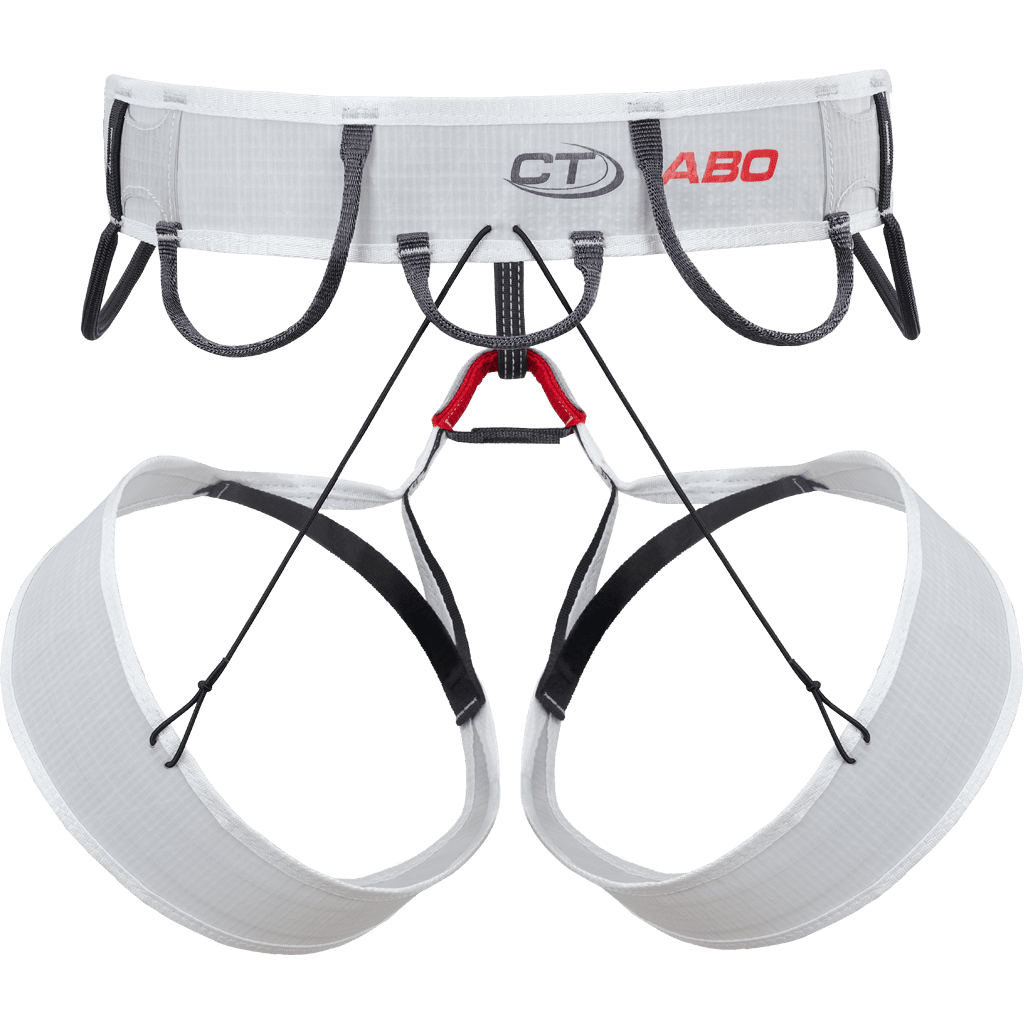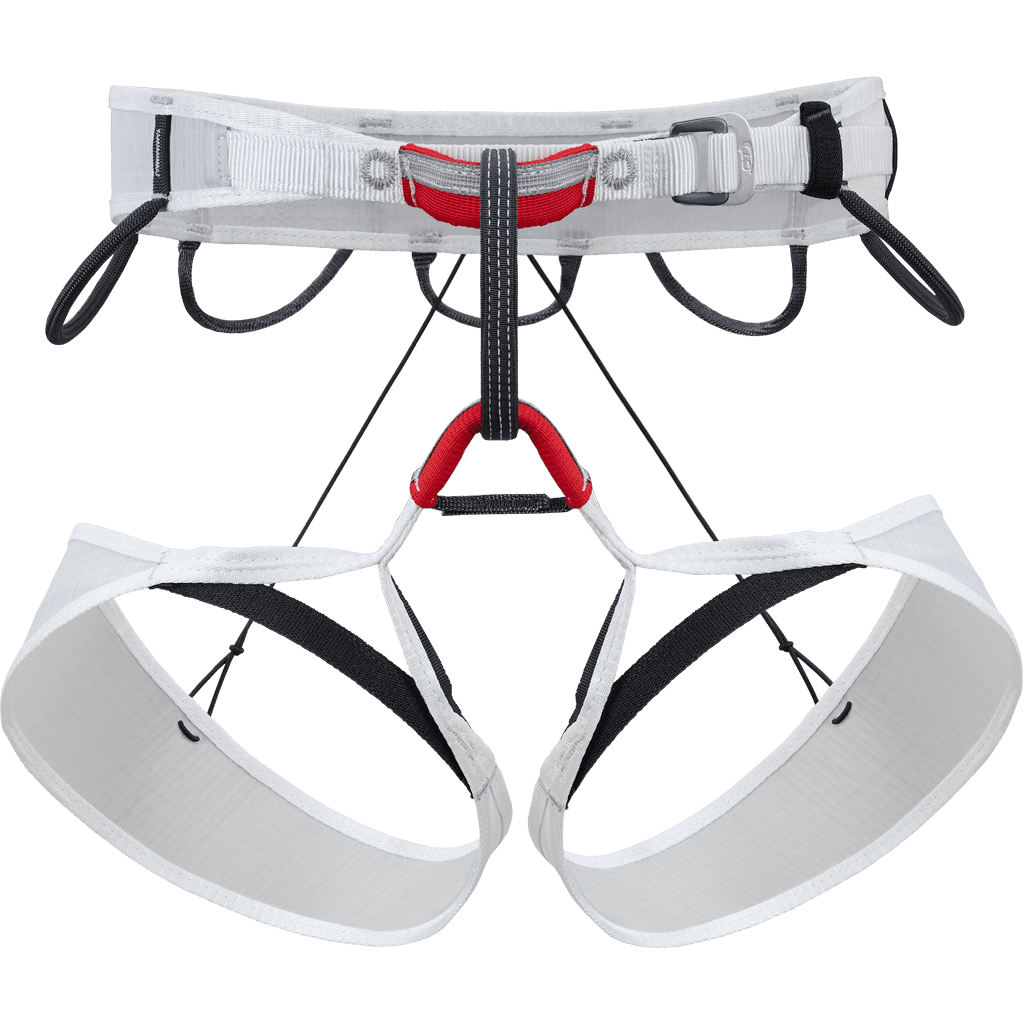Abo, l’imbrago che lascia a bocca aperta
La nostra prova del nuovo ultraleggero di Climbing Technology / Skylotec
Di imbraghi estremi, per leggerezza e scelta dei materiali, ne abbiamo visti e provati diversi nel corso degli ultimi anni, dal Sitta di Petzl al Ghost di Beal al Mosquito di Wild Country per citarne solo alcuni, ma va detto che non c’eravamo mai trovati di fronte a un prodotto così davvero estremo e un po’ sconcertante come questo Abo di Climbing Technology / Skylotec.
Almeno non tra quelli omologati per l’arrampicata sportiva, mentre certamente per l’alpinismo di velocità o per gli imbraghi di emergenza qualcosa del genere in giro c’era già.
Ma qui siamo di fronte davvero a qualcosa di completamente inedito e per questo molto curioso da provare in tutte le varie fasi coinvolte in una giornata di arrampicata.
Per inciso, “Abo” è il grado complessivo assegnato alle vie estreme in montagna…

Il packaging
Partiamo innanzitutto dal packaging: impacchettato, l’imbrago ha poco più delle dimensioni di una carta di credito e comunque viene contenuto all’interno del palmo di una mano maschile: sembra incredibile che sia tutto lì dentro e invece è vero, è ripiegato proprio all’interno di un minuscolo pacchetto, particolare rilevante soprattutto per coloro che si muovono, anche in montagna, dovendo ridurre non soltanto i pesi ma anche gli ingombri del materiale trasportato. E non è nemmeno uno di quei prodotti che una volta tolti dal proprio guscio di vendita non vi rientreranno mai, neanche a viva forza. Nel caso dell’Abo è invece piuttosto facile ripiegare il prodotto e riposizionarlo all’interno della propria sacchetta originaria, quindi conservatela.
Lo stupore al tatto
Una volta estratto dalla confezione, indubbiamente la prima sensazione è di stupore, specie se scali da quasi mezzo secolo e non hai mai collegato un tipo di materiale come quello che stai sentendo sotto le dita a una imbragatura per l’arrampicata. In qualche modo sembra cartone e invece si tratta di un tessuto derivato dalle competizioni di barca a vela, tra l’altro realizzato in materiale riciclato che la casa indica tra il 28 e il 39%. Questo gli permette di essere mono fettuccia e quindi di pesare ridicolmente poco. Anche i porta materiali sembrano quasi incollati alla cintura, cosa che ovviamente non è ma a proposito della “sparizione” delle cuciture quello che stupisce più di tutti è l’anello di servizio, molto ampio.
Volare, appendersi eccetera
Gli ampi elastici dei cosciali consentono effettivamente di adattare il prodotto a una larga fascia di dimensioni di coscia. Sui cosciali si inseriscono gli elastici di regolazione della distanza tra cosciale e cintura e sembrano, almeno a prima vista, il punto debole di questo imbrago. È una sensazione non supportata dalle prove di un utilizzo di lungo periodo, però non è un particolare entusiasmante da vedere e entusiasmante invece è solamente la sensazione di scalare senza avere l’imbragatura perché semplicemente non la si sente addosso e questo è l’effetto principale che probabilmente il costruttore voleva ottenere, obiettivo completamente centrato. Dopo la prima sospensione e soprattutto dopo il primo volo ci si rende conto che l’imbrago c’è, funziona e che non si deve avere alcuna paura ad utilizzarlo anche quando ci si allontana parecchio dall’ultima protezione e si vola. Leggerezza e comfort sono le due principali caratteristiche che un arrampicatore sportivo, ma anche un alpinista che si deve muovere con la maggior leggerezza possibile e i minori ingombri possono chiedere da un imbragatura. E questi l’Abo le garantisce, anche se va detto che non è proprio l’imbragatura ideale per chi fa il super lavorato, cioè per chi si attacca a una via di parecchio superiore al proprio livello e la tempesta di tentativi e quindi di voli e quindi di lunghe soste appeso a cercare di capire una sequenza. In questo caso la leggerezza e le ridotte dimensioni (6 centimetri max la cintura e 7cm max il cosciale) penalizzano il comfort. Ve la consigliamo quindi soprattutto se siete dei climbers da competizione o da scalata a vista. Questo non vuol dire che l’Abo sia male assettato durante i voli o durante le fasi in cui si rimane appesi, come spesso accade con altri prodotti in cui l’anello di servizio va a farsi un giretto o i cosciali si torcono in maniera innaturale e dolorosa. L’Abo è e rimane molto stabile addosso in qualsiasi situazione. Semplicemente il supporto lombare è limitato e quando si sta a lungo appesi si sente.
Le features
I portamateriali sono sorprendentemente abbondanti, addirittura cinque e ben distribuiti, con notevole facilità di estrazione dei rinvii. In più, per soddisfare le esigenze dei ghiacciatori e degli alpinisti di velocità, ci sono due quasi invisibili ma efficaci anelli su cui inserire altrettanti moschettoni portatutto a pera larga.
Infatti è perfetto anche per l’alpinismo di velocità che richiede assoluta leggerezza ma che non prevede lunghe soste scomode appesi alla parete. Ovviamente il cosciale fisso rende difficile montare i ramponi senza toglierlo e impossibile con gli sci, mentre lo vedremmo come un eccellente compagno in ferrata, dove non ci si appende quasi mai ma lo si indossa per l’intera giornata.
I punti di passaggio della corda sono elegantemente in rosso addirittura catarifrangente, anche per renderli più sicuramente individuabili, e sono opportunamente rinforzati. L’elastico per riporre l’eccesso di fibbia è funzionale. L’anello posteriore può essere usato anche come portamagnesite.

Il prezzo
Ci si aspetterebbe che tanta moderna tecnologia costringesse a un prezzo inarrivabile ai più e invece no; i principali concorrenti, peraltro più “pesanti”, Petzl Sitta (media su internet 128 euro), Wild Country Mosquito (media su internet 90€), Beal Ghost (media su internet 95€) costano assai di più dell’Abo, che si porta a casa con un prezzo medio web di 73 euro, ragione in più per farci un pensiero.
Pagina ufficiale e scheda tecniaca del prodotto QUI
English
We’ve seen and tested several extreme harnesses over the past few years, both in terms of lightness and choice of materials—from the Petzl Sitta to the Beal Ghost to the Wild Country Mosquito, to name just a few—but it must be said that we’ve never encountered a product as truly extreme and somewhat disconcerting as this Abo from Climbing Technology / Skylotec.
At least not among those approved for sport climbing, while there certainly was something like this already out there for speed mountaineering or emergency harnesses.
But here we’re really dealing with something completely new, and therefore very interesting to try out in all the various phases involved in a day of climbing.
The Packaging
Let’s start with the packaging: when wrapped, the harness is barely larger than a credit card, yet it fits perfectly into the palm of a man’s hand. It may seem incredible that everything is there, but it’s true: it’s folded up inside a tiny package, a particularly important detail for those who travel, even in the mountains, needing to reduce not only the weight but also the size of their gear. Nor is it one of those products that, once removed from its packaging, will never fit back in, even by force. In the case of the Abo, however, it’s quite easy to fold the product and put it back into its original bag, so keep it safe.
The sense of wonder
Once unpacked, your first sensation is undoubtedly one of wonder, especially if you’ve been climbing for almost half a century and have never connected a material like what you’re feeling under your fingers to a climbing harness. It feels somewhat like cardboard, but it’s actually a fabric derived from sailing competitions, made from recycled material, which the manufacturer specifies is between 28 and 39%. This allows it to be single-weave, making it ridiculously light. Even the gear loops seem almost glued to the belt, which they obviously aren’t. Speaking of the “disappearance” of seams, what’s most surprising is the utility loop, which is very large but seamless.
Flying, hanging, etc.
The wide elastic leg loops effectively allow the harness to be adjusted to a wide range of thigh sizes. The elastic bands that adjust the distance between the leg loops and the waistband are located on the leg loops and seem, at least at first glance, to be this harness’s weak point. This sensation isn’t supported by long-term use, but it’s not an exciting thing to see. What’s exciting is the sensation of climbing without a harness because you simply don’t feel it. This is probably the main effect the manufacturer was aiming for, and they’ve achieved it completely. After the first suspension and especially after the first flight, you realize that the harness is there, it works, and that you shouldn’t be afraid to use it even when you’re far away from the last piece of protection and fall. Lightness and comfort are the two main characteristics that a sport climber, but also a mountaineer who needs to move as lightly as possible and take up as little space as possible, can expect from a harness. And the Abo delivers these, although it must be said that it’s not exactly the ideal harness for those who work hard, that is, those who tackle a route significantly above their level and are subjected to a barrage of attempts, resulting in falls and therefore long periods of hanging while trying to figure out a sequence. In this case, the lightness and small size (6 cm max for the waistbelt and 7 cm max for the leg loops) compromise comfort. We therefore recommend it especially if you’re a competition climber or an onsight climber. This doesn’t mean that the Abo is poorly adjusted during falls or during hanging phases, as often happens with other products where the belay loop takes a turn or the leg loops twist in an unnatural and painful way. The Abo is and remains very stable in any situation. It’s just that the lumbar support is limited, and you feel it when hanging for long periods.
Features
The gear loops are surprisingly generous, with five of them, and well-distributed, making quickdraws remarkably easy to remove. Furthermore, to meet the needs of ice climbers and speed mountaineers, there are two nearly invisible yet effective rings for attaching two large pear-shaped carabiners.
It’s also perfect for speed mountaineering, which requires absolute lightness but doesn’t involve long, uncomfortable stops hanging from the wall. Obviously, the fixed leg loop makes it difficult to attach crampons without removing it, and impossible with skis. However, we would consider it an excellent companion on via ferratas, where you almost never hang from it but wear it all day.
The rope passages are elegantly painted in red, even reflective, to make them more easily identifiable, and are suitably reinforced. The elastic band for storing excess buckle is functional. The rear ring can also be used as a chalk bag.
The price
You might expect such modern technology to come with a price tag that most people wouldn’t be able to afford, but that’s not the case; the main competitors, which are also more “heavy”—the Petzl Sitta (online average 128 euros), the Wild Country Mosquito (online average 90 euros), and the Beal Ghost (online average 95 euros)—cost much more than the Abo, which averages 73 euros online, all the more reason to think about it.


Comments are closed.